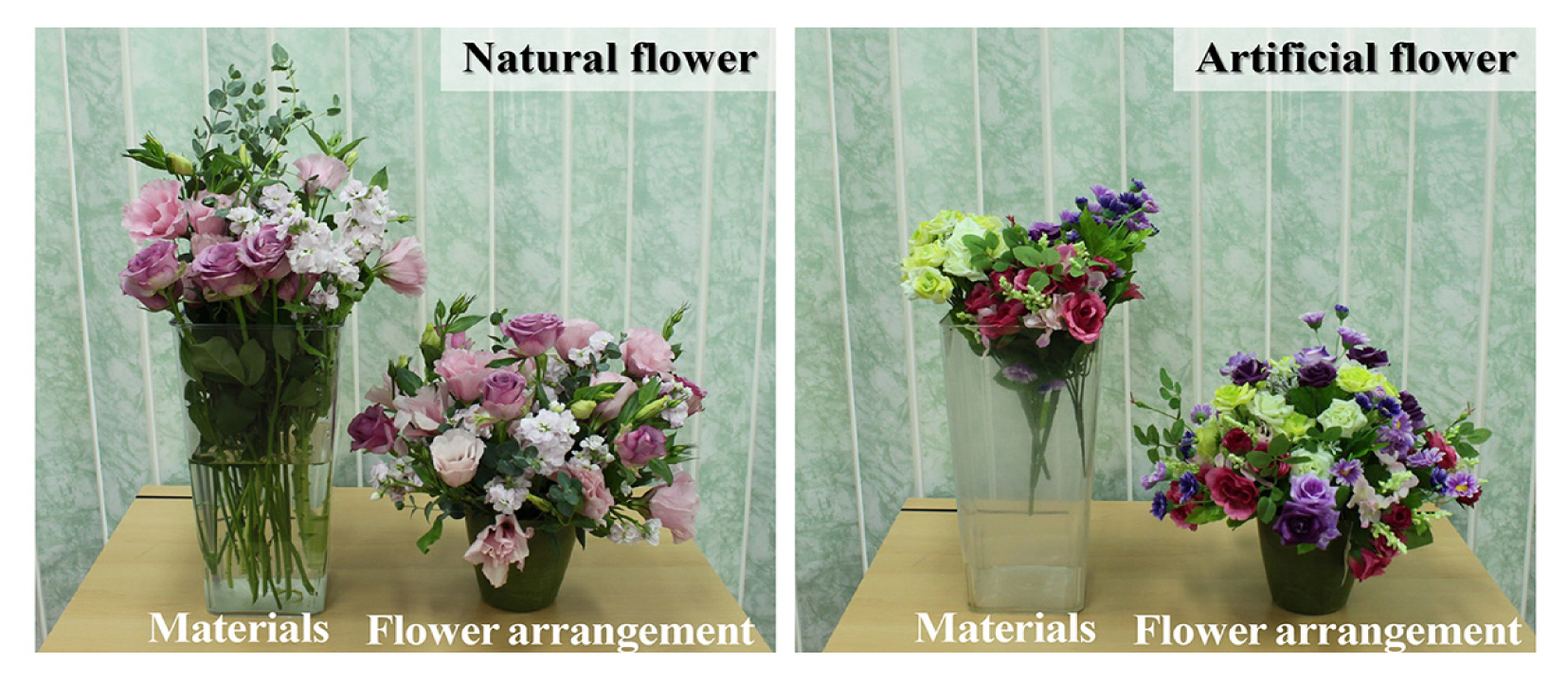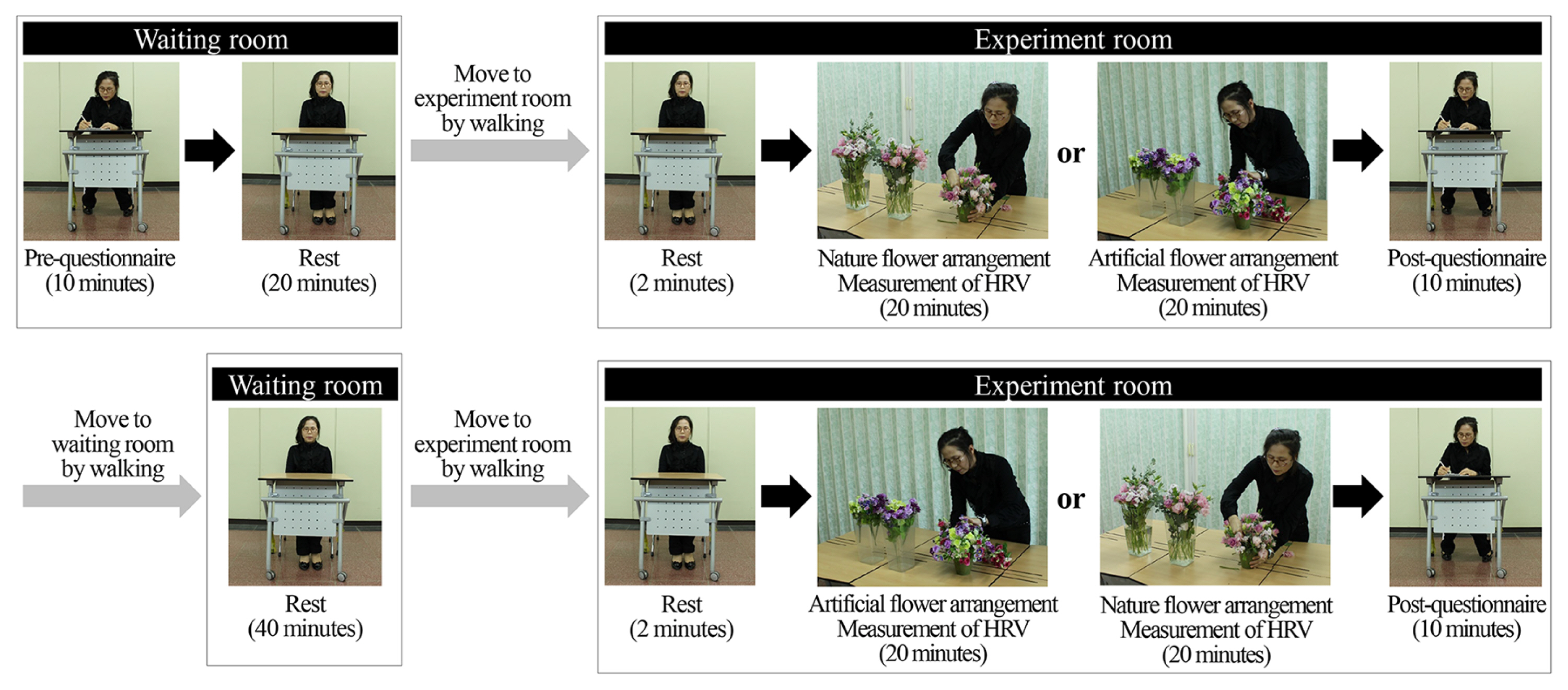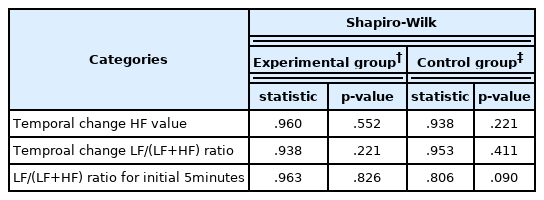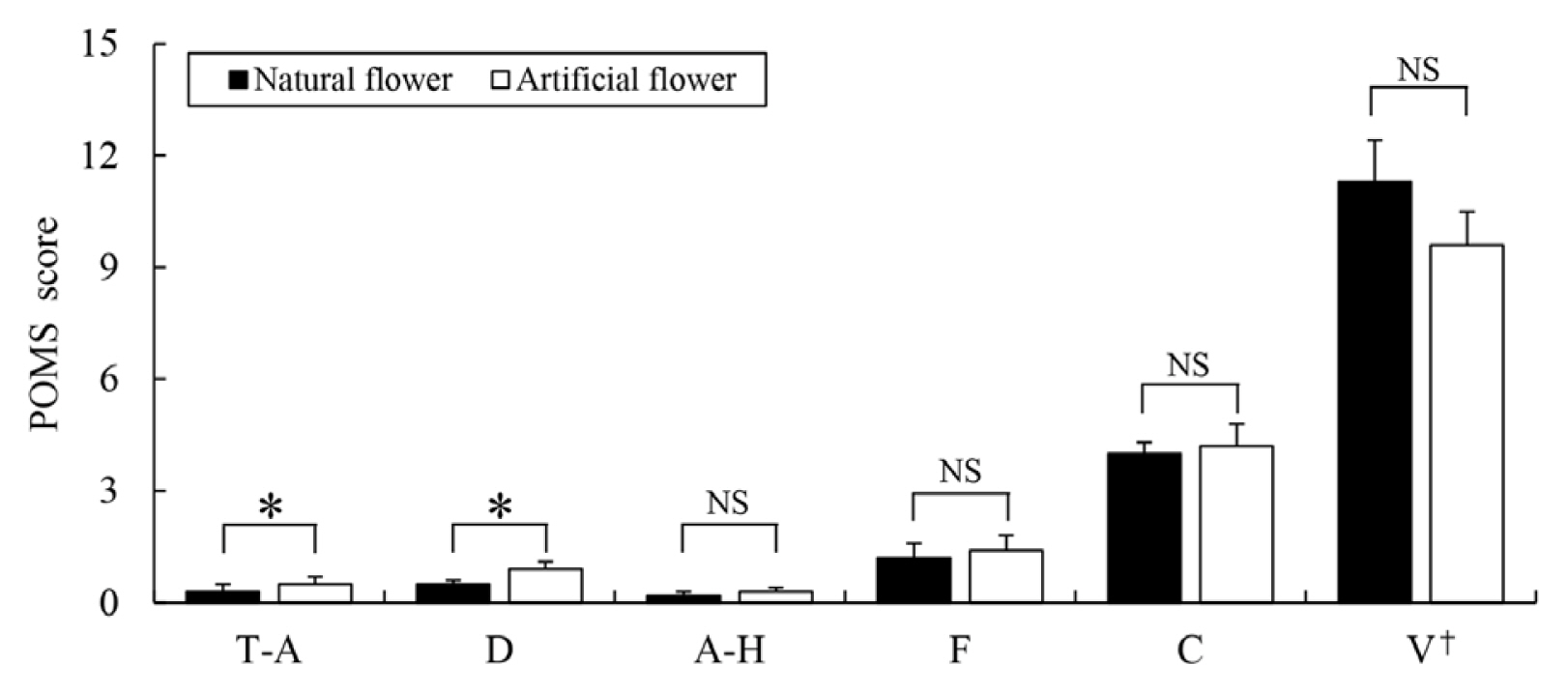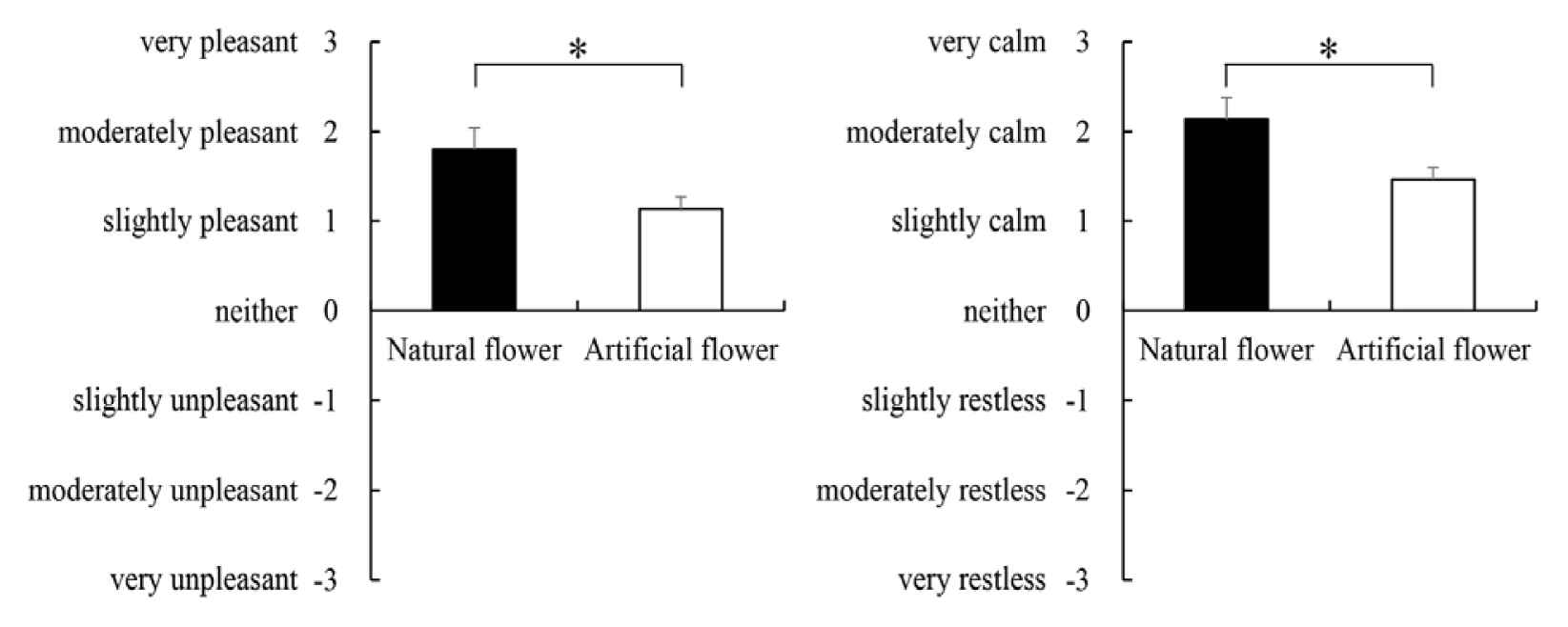Effects of using Natural and Artificial Flowers in Flower Arrangement on Psychological and Physiological Relaxation
Article information
Abstract
Background and objective
The purpose of this study is to investigate the effects of using natural and artificial flowers in flower arrangement on psychological and physiological relaxation.
Methods
In order to clarify the effect of natural flowers in terms of physiological relaxation during flower arrangement work, heart rate variability (HRV) was measured while 15 people were conducting flower arrangement with natural flowers in comparison with artificial flowers. The State-Trait Anxiety Inventory (STAI), Symptom Checklist-90-Revised (SCL-90-R), Profile of Mood States (POMS), and semantic differential (SD) method were used during flower arrangement to investigate the psychological effects.
Results
The physiological relaxation of natural flowers shows that flower arrangement using with natural flowers during the first 5 minutes significantly inhibits sympathetic activity compared to artificial flowers. This result proves that flower arrangement using natural flowers reduces the tension and improve relaxation. As the results of examining the psychological effects, the STAI proves that flower arrangement using natural flowers can better reduce anxiety and relax the subjects than artificial flowers. The result of SCL-90-R test shows that flower arrangement using natural flowers can significantly reduce depression. The result of the POMS shows that flower arrangement using natural flowers can significantly reduce tension, anxiety and depression compared to artificial flowers. The result of the SD method shows that the subjects had a significantly more positive impression of flower arrangement using natural flowers than that using artificial flowers in terms of feeling ‘pleasant’ and ‘calm’.
Conclusion
The result imply that flower arrangement using natural flowers can be more effective for relaxation and recovery from stress and can improve relaxation and calmness of human body compared to artificial flowers.
Introduction
Since humanity has coexisted with nature for a long time, anyone instinctively has a longing for nature and feels relaxed in nature (Wilson, 1984). However, the rapid urbanization since the Industrial Revolution drove the modern society further and further away from nature, and the artificial living environment began to threaten health with stress and various diseases (Neiderud, 2015). For that reason, humans have come to experience the importance of plants and nature, and their interest and awareness of benefits from plants are growing.
Regarding diseases caused by environmental stress, nature therapy that actively uses the natural environment and plants along with modern medicine is recently receiving attention, and various therapeutic measures using plants have emerged as a means of alternative medicine. These therapeutic measures stimulate the human senses and regain health and vitality, while also recovering the physical and mental health of people today stressed in everyday life. Studies have been conducted thus far on how activities involving plants and nature as a plant-based therapy affect the human body such as stability, fatigue, and stress relief. It has been reported that the natural environment lowers blood pressure (Hartig and Staats, 2003) or heart rate (Laumann et al., 2003) caused by stress. It was also discovered that HF levels of heart rate variability (HRV), which is a parasympathetic activity indicator activated in a steady state, gets higher, whereas LF/HF and LF/(LF+HF) levels, which are sympathetic activity indicators that increase in a tension state, get lower (Park and Miyazaki, 2008; Park et al., 2008, 2009; Tsunetsugu et al., 2007). Moreover, there was a study measuring how the images of foliage plants affect changes in brain waves and reporting that foliage plants are effective in physiological relaxation (Son et al., 1999b). As such, not only nature therapy but also horticultural therapy is in desperate need of a scientific approach based on measurement of physiological effect to provide objective grounds and establish therapeutic studies. Recently, studies are actively conducted on how horticultural therapy affects the psychological aspects of humans, as well as on physiological effect by applying complicated technologies such as pulse (Kim and Kim, 2009), blood pressure (Tao et al., 2020), hormone secretion (Yun and Choi, 2010), electrocardiogram (Park et al., 2017), and brain waves (Son et al., 1999a; Hassan et al., 2019, 2020).
Meanwhile, flower arrangement or floral design is creating or installing decorations by expressing the beauty of nature itself as art based on formative skills and creativity of humans using flowering plants as a major material among natural objects. Humans have developed flower arrangement due to their desire to pursue unity with nature (Son, 2004; Lee and Kim, 2010). Recently, flower arrangement is used diversely in horticultural therapy programs, and scientifically proven research data must be accumulated to implement evidence-based horticultural therapy programs. Accordingly, this study was conducted to identify the positive effects of flower arrangement on humans and use the results as basic data in various aspects by scientifically verifying the physiological and psychological effects of making flower decorations with flowering plants on human body.
Research Methods
Flower arrangement
Flower arrangement is creating or installing decorations to enhance spatial functions and aesthetic efficiency by reinterpreting nature with human creativity and expressive-ness to beautifully decorate the human living environment using flowering plants as the main material, and it is a temporal and spatial form of art created based on nature and modeling (Son, 2004; Lee and Kim, 2010). Flower arrangement is mainly classified into Eastern and Western flower arrangement. Western flower arrangement uses floral foams and many cut flowers with focus on shape and composition and is done more freely in creating work compared to Eastern flower arrangement (Han et al., 2005). On the other hand, Eastern flower arrangement has various flower shapes depending on the main branch and angle, but mostly uses pin holders and thus cannot create angles with artificial flowers assembled with wires, and the process of arranging artificial flowers into pin holders requires more skills than arranging them into floral foams (Suh et al., 2005; Lee, 2009). Therefore, this study conducted an experiment of Western flower arrangement using a floral foam. Meanwhile, there are diverse and extensive ways of creating the design for Western flower arrangement, but this study adopted the basic method that is easy to follow by beginners and a simple round shape (hemispheric type) among basic shapes based on geometric form that is easy to find around us (Fig. 1).
Subjects
In the experiment, 15 female adults (mean age: 45.4 ± 5.4) that are mentally and physically healthy and have a high level of understanding about flower arrangement participated voluntarily. The experiment was conducted after the contents were deliberated by the Institutional Review Board (IRB) of Chungnam National University Medical School (IRB No. 09-16). The subjects participated after listening to sufficient explanation about the contents of the experiment the day before and signing the consent form. They were all non-smokers, and they had sufficient sleep the night before the experiment and avoided intake of alcohol and caffeine and immoderate exercises from the day before until right before the experiment.
Research design and method of experiment
This study was conducted in a one-group design. Natural flower arrangement was carried out to measure how flower arrangement using natural flowers relaxes the human body, and artificial flower arrangement was also carried out as a control experiment, The testing materials for flowering plants used in natural flower arrangement were plants that are commonly used in flower arrangement such as roses (Rosa hybrida), stocks (Matthiola incana), lisianthus (Eustoma grandiflorum), and gum trees (Eucalyptus cinerea). In the control experiment, similar artificial flower materials were chosen.
The experiment was conducted from October 1 to October 3, 2010. The subjects came to the venue the day before the experiment to listen to full explanation on the details of the experiment at the orientation and signed the consent form before they participated. On the day of the experiment, they avoided having conversations to keep the experimental conditions equivalent, and they learned the contents and methods of the experiment in advance to maintain a steady state and reduce tension that may occur during the actual experiment. Fluid intake was limited to water only during the experiment so that the subjects could not consume other foods or beverages other than water. Elements that may affect the steady state were eliminated as much as possible.
For the experimental design, total 15 subjects were randomly assigned to four different groups to eliminate the effect of order. The experiment was conducted for two days, with the participation of 8 subjects (2 groups) on the first day and 7 subjects (2 groups) on the second day. The subjects participating on the first day (8 subjects) were divided into the morning and after noon groups to participate in natural and artificial flower arrangement. Group 1 worked on natural flower arrangement first and then artificial flower arrangement, whereas Group 2 worked on artificial flower arrangement first and then natural flower arrangement, thereby eliminating any additional effect by the order of the experiment. On Day 2, 7 subjects (2 groups) also participated in the same way.
The detailed experimental procedures are as follows (Fig. 2). The subjects first filled out four types of questionnaires comprised of STAI, SCL-90-R, POMS, and SD method in the waiting room before the experiment began, after which they relaxed for 20 minutes and then moved to the room for natural flower arrangement (or artificial flower arrangement), where they relaxed for another 2 minutes and then worked on natural flower arrangement (or artificial flower arrangement) for 20 minutes. HRV was measured while they worked for 20 minutes, after which they were to fill out the same four types of questionnaires as before. After the first work, the subjects moved back to the waiting room and relaxed for another 40 minutes, and then moved to the room for artificial flower arrangement (or natural flower arrangement) that is the control group where they relaxed for another 2 minutes and then worked on artificial flower arrangement (or natural flower arrangement). HRV was measured while the subjected worked for 20 minutes, after which they relaxed for 2 minutes and then filled out the questionnaires and moved back to the waiting room. To minimize other elements of stimulation on the physiological or psychological state of the subjects, one subject was to participate in the experimental group and control group experiment sequentially, and the subjects in the afternoon of Day 1 and in Day 2 also participated in the same order.
Measurement indicators
Physiological indicator
(1) Heart rate variability (HRV)
Heart rate variability (HRV) is measuring the responses of the autonomic nervous system using R-R intervals (RRI), measuring the activation of the parasympathetic system that is activated in relaxation and the activation of the sympathetic system that is activated in tension by analyzing the power spectrum for RRI.
In this study, RRI was measured using a portable HRV tracker (Polar RS 400, Polar, Japan), and frequency was analyzed using the Kubios HRV program (University of Eastern Finland, Finland). The range of 0.04–0.15Hz is set as low frequency (LF) and 0.15–0.4Hz as high frequency (HF) to calculate the power spectrum (Malik et al., 1996). In general, HF is affected by parasympathetic activity, while LF is affected by both parasympathetic and sympathetic systems. In this study, HF was used as an indicator of parasympathetic activity (Cacioppo et al., 1994), and LF/(LF+ HF) as an indicator of sympathetic activity (Weise and Heydenreich, 1989).
Psychological indicators
(1) State-trait anxiety inventory (STAI)
State-Trait Anxiety Inventory (STAI) is a tool developed by Spielberger in 1972 used to measure state anxiety and is widely used as a measure for anxiety (Spielberger, 1972; Kim and Shin, 1978). STAI is comprised of 20 items measuring state anxiety such as concerns, tension, hypersensitivity, and worries currently faced by the subjects and 20 items measuring trait anxiety such as the general anxiety of the subjects, which are rated on a 4-point self-report scale. The range of individual scores is 20–80 points, and higher total scores indicate higher anxiety. This study used the state anxiety tool measuring the anxiety of the subjects after participating in the experimental and control group experiments.
(2) Symptom checklist-90-revised (SCL-90-R)
Symptom Checklist-90-Revised (SCL-90-R) is a checklist for psychological symptoms developed by Derogatis and Cleary (1977) and is widely used in measuring mental state (Derogatis and Cleary, 1977; Kim and Kim, 1984). SCL-90-R is comprised of 90 items, with total 9 dimensions of symptoms such as somatization (SOM), obsessive-compulsive disorder (O-C), interpersonal sensitivity (I-S), depression (DEP), anxiety (ANX), hostility (HOS), phobic anxiety (PHOB), paranoid ideation (PAR), and psychoticism (PSY). The subjects rate the items on a 5-point self-report scale depending on the level of symptoms experienced in the last 7 days including that day, and lower scores indicate better mental health.
(3) Profile of mood states (POMS)
The Profile of Mood States (POMS) is a tool developed in 1964 to measure the human mood or emotional state and has been widely used in studies predicting mood changes affected by the environment or human relations (McNaire and Lorr, 1964). The POMS classifies the mood of respondents into tension-anxiety, depression-dejection, anger-hostility, vigor-activity, confusion-bewilderment, and fatigue-inertia (McNaire and Lorr, 1964). The POMS is comprised of total 60 items, but there is also the short form comprised of 30 items. This study used the short form with 30 items to test the mood states of the subjects.
(4) Semantic differential (SD) method
The SD method measures the human minds with adjectives expressing human emotions and was developed by Osgood (1969) for cross-cultural studies investigating how similar the meanings are among vocabularies around the world. It has since been widely used in landscape evaluation or appraisal and assessment including human sensibility ergonomics. This study rated emotional states of the subjects on a 7-point self-report scale after the experiment using adjectives such as pleasant-unpleasant and calm-anxious.
Analysis method
The statistical analysis on the results of this study was conducted using SPSS (Statistical Package for Social Science, Illinois, USA). The Shapiro-Wilk test was conducted to test the normality of collected data, and the paired t-test (parametric statistics) was conducted for items satisfying the assumption of normality for measures of both the experimental group and control group. Items that do not satisfy the assumption of normality in either one of the two groups were tested using the Wilcoxon signed-rank test (non-parametric statistics). All statistical analyses were conducted in a one-tailed test, and the significance level was p < .05.
Results and Discussion
Results of physiological indicators
Normality test on physiological indicators
The results of the ‘Shapiro-Wilks normality test’ on the measures of physiological indicators for the experimental group (natural flowers) and control group (artificial flowers) are as shown in Table 1.
As a result of the normality test of the two groups, all items analyzed satisfied normal distribution.
Heart rate variability (HRV)
Changes in HRV while performing natural and artificial flower arrangement are as shown in Fig. 3. HF, which is activated in relaxation as an indicator of parasympathetic activity, was significantly higher in natural flower arrangement than artificial flower arrangement at 11 minutes and 13 minutes. LF/(LF+HF), which increases in tension as an indicator of sympathetic activity, was significantly lower in natural flower arrangement than artificial flower arrangement at 3 minutes and 5 minutes. Meanwhile, LF/(LF+HF) during 20 minutes of natural flower arrangement tended to decrease significantly for approximately 5 minutes after starting arrangement compared to the value during artificial flower arrangement (Fig. 4). Considering the significant decrease in LF/(LF+HF) that is an indicator of sympathetic activity during the first 5 minutes of natural flower arrangement, flower arrangement using natural flowers alleviates tension and relaxes the subjects.

Temporal changes HF value and LF/(LF+HF) ratio of HRV (Heart rate variability) while working for flower arrangement work with natural and artificial flowers. *: p < .05, p-value by paired t-test (Mean ± SE), N = 15.
Results of psychological indicators
Normality test on psychological indicators
The results of the ‘Shapiro-Wilks normality test’ on the measures of psychological indicators for the experimental group (natural flowers) and control group (artificial flowers) are as shown in Table 2.
As a result of the normality test of the two groups, the subscale of STAI and SCL-90-R such as somatization (SOM) and the subscale of the POMS such as vigor (V) satisfied normality in both groups. The subscales of SCL-90-R such as interpersonal sensitivity (I-S) and hostility (HOS) satisfied normality in the experimental group, but not in the control group. The subscale of the POMS such as confusion (C) did not satisfy normality but satisfied normality in the control group. Other items all did not satisfy normality.
State-trait anxiety inventory (STAI)
The measurement results of anxiety are as shown in Fig. 5. The state anxiety was 30.8 ± 1.53 after natural flower arrangement and 34.9 ± 1.53 after artificial flower arrangement, showing that the state anxiety score became significantly low after natural flower arrangement (p < .01). This indicates that, compared to artificial flower arrangement, natural flower arrangement reduces anxiety and relaxes the subjects relatively more.
Symptom checklist-90-revised (SCL-90-R)
The results of SCL-90-R are as shown in Fig. 6. Somatization was 15.6 ± 0.8 after natural flower arrangement and 16.1 ± 0.9 after artificial flower arrangement, thereby not showing a significant difference. Obsessive-compulsive disorder was 17.2 ± 1.61 after natural flower arrangement and 17.5 ± 1.54 after artificial flower arrangement, thereby not showing a significant difference. Interpersonal sensitivity was 14.2 ± 1.25 after natural flower arrangement and 14.2 ± 1.18 after artificial flower arrangement, thereby not showing a significant difference. Depression was 18.3 ± 1.84 after natural flower arrangement and 21.0 ± 1.83 after artificial flower arrangement, proving that depression showed a statistically significant decrease after natural flower arrangement (p < .05). Anxiety was 13.5 ± 1.23 after natural flower arrangement and 13.7 ± 1.16 after artificial flower arrangement, thereby not showing a significant difference. Psychological hostility was 7.33 ± 0.47 after natural flower arrangement and 7.53 ± 0.35 after artificial flower arrangement, thereby not showing a significant difference. Psychological phobic anxiety was 8.46 ± 0.67 after natural flower arrangement and 8.54 ± 0.65 after artificial flower arrangement, thereby not showing a significant difference. Paranoid ideation was 8.0 ± 0.54 after natural flower arrangement and 8.07 ± 0.54 after artificial flower arrangement, thereby not showing a significant difference. Psychoticism was 12.0 ± 0.64 after natural flower arrangement, which was significantly lower than 13.5 ± 0.73 after artificial flower arrangement (p < .05).

Comparison of score tested by the SCL-90-R method after flower arrangement work with natural and artificial flowers. SOM: somantization; O-C: obsessive-compulsive; I-S: interpersonal sensititivy; DEP: depression; ANX: anxiety; HOS: hostility; PHOB: phobic anxiety; PAR: paranoid ideation; PSY: psychoticism. *: p < .05, †: paired t-test, no mark: Wilcoxon signed-rank test, N=15.
Profile of mood states (POMS)
The results of the POMS are as shown in Fig. 7. Tension-anxiety was 0.3 ± 0.2 after natural flower arrangement and 0.5 ± 0.2 after artificial flower arrangement, indicating that tension-anxiety was significantly lower after natural flower arrangement than after artificial flower arrangement (p < .05). Depression was 0.5 ± 0.1 after natural flower arrangement, which was significantly lower than 0.9 ± 0.2 after artificial flower arrangement (p < .05). Anger was 0.2 ± 0.1 after natural flower arrangement and 0.3 ± .1 after artificial flower arrangement, thereby not showing a significant difference. Fatigue was 1.2 ± 0.4 after natural flower arrangement and 1.4 ± 0.4 after artificial flower arrangement, thereby not showing a significant difference. Confusion was 4.0 ± 0.3 after natural flower arrangement and 4.2 ± 0.6 after artificial flower arrangement, thereby not showing a significant difference. Vigor was 11.3 ± 1.1 after natural flower arrangement and 9.6 ± 0.9 after artificial flower arrangement, thereby not showing a significant difference.
Semantic differential (SD) method
The results of rating pleasant and calm state during flower arrangement using SD are as shown in Fig. 8. Comparing the results after natural flower arrangement and artificial flower arrangement, it was found that natural flower arrangement significantly makes the subjects feel pleasant and calm.
Conclusion
The purpose of this study is to scientifically verify the physiological and psychological effects of flower arrangement using natural and artificial flowers and determine whether flower arrangement actually has a positive effect on not only psychological but also physical aspects of humans.
The physiological assessment in this study showed that LF/(LF+HF), which is an indicator of sympathetic activity, became significantly low from the beginning of natural flower arrangement up to 5 minutes. This significant difference in HRV at the beginning of work is due to the fact that the subjects concentrate more on creating the flower shapes as time passes and thus the detectability of change due to the difference between natural and artificial flowers decreases compared to the beginning.
Meanwhile, the psychological assessment showed statistically significant results in items such as depression and psychoticism of SCL-90-R and STAI, tension-anxiety and depression of the POMS, and pleasant and calm measured with SD. These results are partially consistent with previous studies reporting that real plants show lower anxiety than artificial plants and higher levels of emotions such as comfortable, relaxed, and natural (Hassan et al., 2019; Igarashi et al., 2015). Moreover, the results of this study are similar to those of previous studies revealing that plants increase confidence and sociality of humans and recover them from anxiety or tension (Kum, 2001), and that encountering nature improves cognitive and emotional resilience of humans and increases psychological relaxation (Kaplan and Talbot., 1983; Herzog et al., 1997; Kaplan, 2001), while also providing various psychological benefits.
This study is on the relationship between plants and humans, and the results imply that horticultural activities or garden plants reduce psychological and maintain peacefulness, and being close to plants also promotes psychological relaxation. Furthermore, previous studies on horticultural therapy programs using flower arrangement proved that flower arrangement programs in the middle age improve self-esteem and reduce hopelessness (Ha, 2005), and the results were also effective in the age group of the subjects in this study.
This study has a few limitations in terms of gender, age, and the number of subjects as well as hours spent on flower arrangement. It has significance as a study on biological change that has not been studied in flower arrangement before, but it has relatively fewer comparative data on the subjects and the experimental group as the basic study as well as fewer hours spent on flower arrangement. Thus, there are limitations in measuring the ability to recover from fatigue that may occur during the arrangement work. Although the results are obtained from a limited group, individual differences were minimized in the experimental design to obtain more objective results.
In sum, flower arrangement using natural flowers physiologically reduces tension and provides relaxation, and psychologically increases comfort and vigor and makes the subjects feel calm and pleasant, which proves that natural flower arrangement is effective in psychological and physiological relaxation.
This indicates that flower arrangement using natural flowers can be applied to both everyday life and horticultural therapy and will be basic data for future research.

